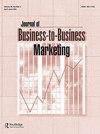销售组织的新规范:技术在环境动荡中的影响
IF 2.5
4区 管理学
Q3 BUSINESS
引用次数: 2
摘要
由于最近的COVID-19大流行,许多销售组织正在进行虚拟工作,并与客户建立不同的联系。这场大流行是环境动荡的一个主要例子,为了应对这场大流行,许多公司面临着更具创新性的挑战,以保持与客户的沟通和协作(Hartmann and Lussier 2020)。动荡是商业环境中制约组织行为和绩效的一个因素。这使得销售人员开始关注协作工具和实践,以支持虚拟销售环境的新规范。在过去的两年中,销售组织与客户和潜在客户进行面对面会议的能力受到了限制。由于疫情,面对面的会议、午餐、会议、商业活动几乎都消失了。然而,建立渠道、交付销售成果和完成配额的责任从未消失。销售组织已经展示了通过坚韧和技术创新的弹性来茁壮成长的能力。动荡对绩效的影响已经在一系列实证研究中进行了调查,主要集中在私营部门组织。这些研究中的大多数支持湍流对绩效有负面影响的命题(例如,Anderson和Tushman 2001;Li and Atuahene-Gima and Ko 2001;Kuivalainen et al. 2004;Lin and Germain 2003)。然而,先前的研究表明,在动荡的环境中,企业往往会比在稳定的环境中做出更多的调整和适应来获得成功(Sawyer 1993)。Miller(1987)认为,随着感知到的环境动荡的增加,企业应该更多地关注创新,以从环境和组织中获得优势。企业对企业(B2B)组织经历了各种挑战,如销售过程中利益相关者数量的增加、客户知识、竞争、技术进步和全球化(Arli, Bauer, and Palmatier 2018;Hartmann, Wieland, and Vargo 2018;Lim 2020;Lussier and Hartmann 2017)。本文的目的是在现有研究的基础上,提出一个概念模型,说明销售生态系统的弹性能力,并利用技术来应对最近大流行给销售组织带来的挑战。在本文中,我们概念化了环境湍流如何影响性能。以资源基础观点(RBV)为基础,我们讨论了销售技术在环境动荡和销售绩效之间的调节关系(见图1)。本研究建立在现有销售技术文献的基础上,并讨论了即使在充满挑战的时代,销售组织如何不仅能生存,而且能在确定性时期蓬勃发展。研究的第一步是从环境湍流和RBV的角度提出理论背景。接下来,我们展示开发的模型(见图2)及其对协作和销售绩效的影响。未来的研究和管理的启示,然后提供讨论积极的本文章由计算机程序翻译,如有差异,请以英文原文为准。
The New Norm for Sales Organizations: Impact of Technology During Environmental Turbulence
Many sales organizations are working virtually and connecting with customers differently because of the recent COVID-19 pandemic. In response to this pandemic, which is a prime example of environmental turbulence, many companies are challenged to be more innovative to maintain communication and collaboration with customers (Hartmann and Lussier 2020). Turbulence is an element of the business environment that constrains organizational behavior and performance. This has placed a focus on salespeople embracing collaboration tools and practices to support the new norm of the virtual sales environment. In the last two years, sales organizations’ ability to conduct face-to-face meetings with clients and prospects have been limited. Face-to-face meeting, luncheons, conferences, business events were all but gone due to the pandemic. Yet the responsibility of creating pipeline, delivering sales results and attaining quota never disappeared. Sales organizations have shown the ability to thrive through resiliency through not only grit but technical innovation. The impact of turbulence on performance has been investigated in a series of empirical studies, mostly focused on private sector organizations. A majority of these studies support the proposition that turbulence has a negative effect on performance (e.g., Anderson and Tushman 2001; Li and Atuahene-Gima and Ko 2001; Kuivalainen et al. 2004; Lin and Germain 2003). However, previous research suggests that in a turbulent environment, a firm will tend to make more adjustments and adaptations to become successful than in a stable environment (Sawyer 1993). Miller (1987) argues that as perceived environmental turbulence increases, the firm should devote more attention to innovation to gain advantages from its environment and for the organization. Business-to-business (B2B) organizations have experienced challenges such as an increase in the number of stakeholders in the sales process, customer knowledge, competition, advancements in technology and globalization (Arli, Bauer, and Palmatier 2018; Hartmann, Wieland, and Vargo 2018; Lim 2020; Lussier and Hartmann 2017). The objective of this paper is to build off this existing research and present a conceptual model illustrating the sales ecosystem’s ability to exemplify resilience and leverage technology to address the challenges the recent pandemic has presented to sales organizations. In this paper we conceptualize how environmental turbulence can impact performance. Using resource-based view (RBV) as the foundation we discuss the moderating relationship sales technology has between environmental turbulence and sale performance (see Figure 1). This study builds off the existing sales technology literature and discusses how even in challenging times, sales organizations cannot only survive but thrive during times of certainty. Our first step in the research is to present the theoretical background from the perspective of environmental turbulence and RBV. Next, we present the developed model (see Figure 2) and its influence on collaboration and sales performance. Future research and managerial implications are then provided to discuss the positive
求助全文
通过发布文献求助,成功后即可免费获取论文全文。
去求助
来源期刊
CiteScore
2.20
自引率
35.70%
发文量
22
期刊介绍:
The Journal of Business-to-Business Marketing® encourages diversity in approaches to business marketing theory development, research methods, and managerial problem solving. An editorial board comprised of outstanding, internationally recognized scholars and practitioners ensures that the journal maintains impeccable standards of relevance and rigorous scholarship. The Journal of Business-to-Business Marketing features: •basic and applied research that reflects current business marketing theory, methodology, and practice •articles from leading researchers covering topics of mutual interest for the business and academic communities

 求助内容:
求助内容: 应助结果提醒方式:
应助结果提醒方式:


